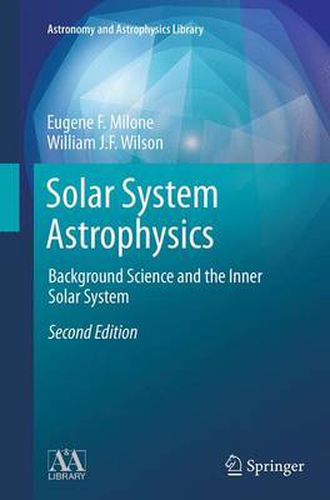Readings Newsletter
Become a Readings Member to make your shopping experience even easier.
Sign in or sign up for free!
You’re not far away from qualifying for FREE standard shipping within Australia
You’ve qualified for FREE standard shipping within Australia
The cart is loading…






This title is printed to order. This book may have been self-published. If so, we cannot guarantee the quality of the content. In the main most books will have gone through the editing process however some may not. We therefore suggest that you be aware of this before ordering this book. If in doubt check either the author or publisher’s details as we are unable to accept any returns unless they are faulty. Please contact us if you have any questions.
The second edition of Solar System Astrophysics: Background Science and the Inner Solar System provides new insights into the burgeoning field of planetary astronomy. As in the first edition, this volume begins with a rigorous treatment of coordinate frames, basic positional astronomy, and the celestial mechanics of two and restricted three body system problems. Perturbations are treated in the same way, with clear step-by-step derivations. Then the Earth’s gravitational potential field and the Earth-Moon system are discussed, and the exposition turns to radiation properties with a chapter on the Sun. The exposition of the physical properties of the Moon and the terrestrial planets are greatly expanded, with much new information highlighted on the Moon, Mercury, Venus, and Mars.
All of the material is presented within a framework of historical importance. This book and its sister volume, Solar System Astrophysics: Background Science and the Inner Solar system, are pedagogically well written, providing clearly illustrated explanations, for example, of such topics as the numerical integration of the Adams-Williamson equation, the equations of state in planetary interiors and atmospheres, Maxwell’s equations as applied to planetary ionospheres and magnetospheres, and the physics and chemistry of the Habitable Zone in planetary systems.
Together, the volumes form a comprehensive text for any university course that aims to deal with all aspects of solar and extra-solar planetary systems. They will appeal separately to the intellectually curious who would like to know how just how far our knowledge of the solar system has progressed in recent years.
$9.00 standard shipping within Australia
FREE standard shipping within Australia for orders over $100.00
Express & International shipping calculated at checkout
This title is printed to order. This book may have been self-published. If so, we cannot guarantee the quality of the content. In the main most books will have gone through the editing process however some may not. We therefore suggest that you be aware of this before ordering this book. If in doubt check either the author or publisher’s details as we are unable to accept any returns unless they are faulty. Please contact us if you have any questions.
The second edition of Solar System Astrophysics: Background Science and the Inner Solar System provides new insights into the burgeoning field of planetary astronomy. As in the first edition, this volume begins with a rigorous treatment of coordinate frames, basic positional astronomy, and the celestial mechanics of two and restricted three body system problems. Perturbations are treated in the same way, with clear step-by-step derivations. Then the Earth’s gravitational potential field and the Earth-Moon system are discussed, and the exposition turns to radiation properties with a chapter on the Sun. The exposition of the physical properties of the Moon and the terrestrial planets are greatly expanded, with much new information highlighted on the Moon, Mercury, Venus, and Mars.
All of the material is presented within a framework of historical importance. This book and its sister volume, Solar System Astrophysics: Background Science and the Inner Solar system, are pedagogically well written, providing clearly illustrated explanations, for example, of such topics as the numerical integration of the Adams-Williamson equation, the equations of state in planetary interiors and atmospheres, Maxwell’s equations as applied to planetary ionospheres and magnetospheres, and the physics and chemistry of the Habitable Zone in planetary systems.
Together, the volumes form a comprehensive text for any university course that aims to deal with all aspects of solar and extra-solar planetary systems. They will appeal separately to the intellectually curious who would like to know how just how far our knowledge of the solar system has progressed in recent years.